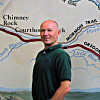
|

|
|
How I teach, by Jan Cerny
After 25 years of teaching languages
I have created a system that serves best to anybody who wants to study a foreign
language. It is based on three principles:
-
Conversation is what matters.
-
Hearing comes before seeing.
- Put all
five senses to utmost use.
|

|
First, nothing can be more important for a student of a foreign language studies
than to be able to express their ideas in a coherent and concise way. The
only way that an adult student will ever hope to accomplish this is when they
will have enough time to practice communicating their ideas to his or her
foreign language partner. Notice that it is not only about vocabulary.
It is about using all the words the student knows and never be shy to do it.
My rule-of-thumb therefore is to give as much time to conversation as possible.
Generally I can say that my students spend about two-thirds of their lesson
practicing their ability to speak.
|

|
|
Second, my students never see the word or sentence or the text before they hear
it. No one in a foreign country will come up to you and show you text
written on a piece of paper. They will simply say it, and that is exactly
how PLS class sessions are conducted. You will first hear every
word before you will ever see it. The text will be spoken either by me or
by other, usually native speakers. Then you will repeat it and use it in a
sentence or sentences. It will never happen that you arrive in a foreign
country and not be able to understand what they are saying because you were
accustomed to seeing text first before hearing it.
|

|
|
Third, I want my students to not only hear the word, but also to (subsequently)
see it, and say it out loud, write it down, and if necessary to enact it.
I strongly recommend to my students to have a journal available during lessons,
where they will write new vocabulary into it and later practice it. If you
think it is too old-fashioned, let me help you understand better with an
illustration. Learning a language is kind of like building a house. The
more bricks one has, the better the house will look like. The more words
you know and can appropriately place in the sentence, the better you will
express yourself. Also, when building a house, you need to connect the
bricks with mortar or the house will crumble to the ground. Grammar serves
as mortar for anybody who studies languages. That is why I spend some time
during the lesson on explaining the grammar to the students and I make sure they
understand its basic principles.
|

|
|
The Great
Insertion, by Jan Cerny For
your information, please examine our teaching method which I call “Great
Insertion”.
When a student wants to say something but does not know
the word or cannot recall the word, the student struggles, and at that moment
creates a terrific yearning to supply the right word. Indeed, the brain longs
for the word and does everything possible to insert the right word into a space
that is reserved for it.
In my classes, several things happen in this moment of
word struggle:
-
I wait and
encourage the student to say what he or she is attempting to say.
-
When it is
obvious that the student is stuck, I will clearly utter the word the student
wants to say so much. There is no doubt that the brain accepts the
word with much greater enthusiasm and vigor, since it has so desperately
waited for it.
-
Now knowing the word, the student
eagerly repeats the word and uses it in the sentence. While the
student is still speaking, I write the word into my notebook, and at the end
of the conversation lesson I offer it back to the student at which time the
word is reviewed again, and finally, the student then writes the word down
into a personal journal. The student will practice and study the
trouble words at home, and will be reviewed again during the next
conversation lesson.
Of course, I will not reveal all the “Great Insertion”
secrets. But I am happy to give this much away (mentioned above) to other
teachers and to you, so that everyone may be familiar in advance with the
methods we employ.
|

|
|
|
|
|
